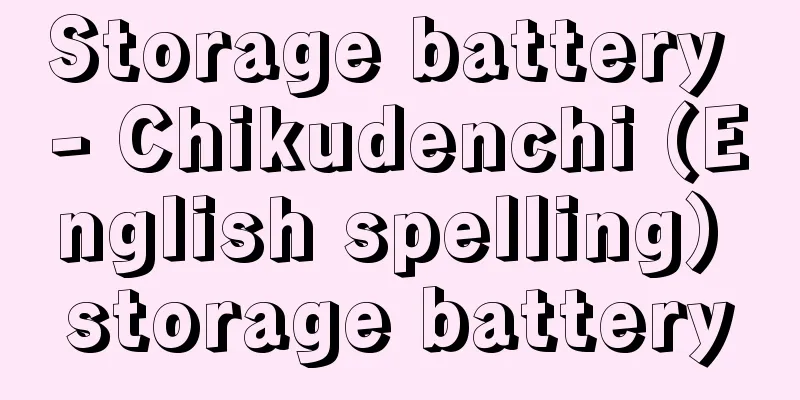Storage battery - Chikudenchi (English spelling) storage battery

|
A battery that can be repeatedly charged and discharged, and can supply stored electricity as needed. It is also called a secondary battery. It generally consists of plates made of reversible positive and negative active materials, an electrolyte, a separator, and a battery case. It is required to have a high energy density and output density, excellent reversibility of charging and discharging, and excellent cycle characteristics, and to be usable for a long period of time. In addition, sealed structures have been developed to improve safety and reliability. There are lead-acid batteries whose electrolyte is an aqueous sulfuric acid solution, nickel-cadmium batteries, which are called alkaline batteries because they use an alkaline aqueous solution, nickel-hydrogen batteries that use hydrogen storage alloys, high-pressure nickel-hydrogen batteries that use high-pressure hydrogen gas, silver-zinc batteries, nickel-iron batteries, nickel-zinc batteries, and metal-air batteries that use metals such as iron, zinc, or aluminum and oxygen in the air. In addition, there are lithium-ion secondary batteries that use carbon as the anode host material, and lithium secondary batteries that use alloys, metal oxides, metal nitrides, etc. other than carbon. These generally use aprotic organic solvents with electrolyte salts dissolved in them as electrolytes, but all-solid-state batteries using solid electrolytes have been developed. Other high-temperature batteries include sodium-sulfur batteries, sodium-nickel chloride batteries (zebra batteries), and silver-iodine batteries that use inorganic solid electrolytes, as well as lithium iron disulfide batteries that use molten salt electrolytes. The electrolyte circulation type battery includes redox flow batteries that use vanadium or iron-chromium electrolytes as the active material, and zinc-halogen batteries that use chlorine or bromine as the positive electrode active material. The electrolyte active material can be regenerated by charging and reused, so it is also called a regenerative battery. Of these, the four most important types of batteries for practical use are lead-acid batteries, nickel-cadmium batteries, nickel-metal hydride batteries, and lithium-ion secondary batteries. Lead-acid batteries are mostly used for starting automobiles, and are economical and reliable. Nickel-cadmium batteries are interchangeable with nickel-cadmium batteries, and have come to be used in place of nickel-cadmium batteries due to environmental concerns. They have a high energy density and good high-rate discharge characteristics, and are used not only as power sources for small electronic devices, but also in fields that require high output, such as electric vehicles and hybrid cars, as well as electrically assisted bicycles, cordless vacuum cleaners, and power tools. Lithium-ion secondary batteries have a high battery voltage of 3.0 volts or more, and are widely used as small, high-energy-density sealed batteries for laptops, mobile phones, and personal digital assistants, and production is expanding. In addition, active research is being conducted on their use in electric vehicles and hybrid cars. [Mitsuru Asano] "Battery User's Guide" by Takamura Tsutomu and Sato Yuichi (1988, Corona Publishing) " ▽ "Batteries - Their Chemistry and Materials" by Takehara Zenichiro (1988, Dainippon Tosho)" ▽ "Illustrated Guide to Batteries" by Ikeda Hironosuke (ed.), Takeshima Genji and Umeo Yoshiyuki (1996, Nihon Jitsugyo Publishing)" ▽ "Battery Book for Properly Using an Essential Item in Modern Life" revised edition by Nishimura Akiyoshi (1996, CQ Publishing)" ▽ "Battery Handbook" edited by David Linden and translated by Takamura Tsutomu (1996, Asakura Publishing)" ▽ "The Latest Technology of New Secondary Battery Materials" edited by Ogumi Zenpachi (1997, CMC)" ▽ "The Science of Batteries - A Great Supporting Player in Our Lives" by Okada Kazuo (1997, Morikita Publishing)" ▽ "The Latest Technology of Secondary Battery Materials" edited by Ogumi Zenpachi, popular edition (1999, CMC)" ▽ "The Latest Practical Secondary Batteries: How to Select and Use" edited by Japan Battery Co., Ltd. (1999, Nikkan Kogyo Shimbun)" ▽ "Electrochemistry" edited by Ogumi Zenpachi (2000, Ohmsha)" ▽ "Electrochemical Society edited, Electrochemistry Handbook (2000, Maruzen)" ▽ "Battery Handbook Editorial Committee edited, Battery Handbook (2001, Maruzen)" ▽ "Secondary Battery Technology for Beginners" edited by Ogumi Zenpachi and Ikeda Hironosuke (2001, Industrial Research Institute)" ▽ "Materials Chemistry of New Batteries: Quarterly Chemistry Review No. 49" (2001, Academic Press)" ▽ "Development and Materials of New Energy Vehicles" edited by Yamada Koichi and Sato Noboru (2001, CMC)" ▽ "Development and Materials of Secondary Batteries" Popular Edition (2002, CMC) [References] | | | | | | | | | |©Takashi Aoki Principle of electromotive reaction in lead-acid batteries Method using paste-type electrodes ©Takashi Aoki "> Example of the structure of an automotive lead-acid battery Source: Shogakukan Encyclopedia Nipponica About Encyclopedia Nipponica Information | Legend |
|
充放電を繰り返して使用できる電池で、必要に応じて貯蔵した電力を供給することができる。二次電池、バッテリーともいう。一般に可逆性のある正負活物質からなる極板と電解質、隔離板(セパレーター)、電槽などから構成されている。エネルギー密度と出力密度が大きく、充放電の可逆性とそのサイクル特性に優れ、長期間使用できることが求められている。また安全性と信頼性を高めるために、密閉構造としたものが開発されている。 蓄電池には、電解液が硫酸水溶液の鉛蓄電池と、アルカリ水溶液を用いるためアルカリ蓄電池とよばれるニッケルカドミウム蓄電池、水素吸蔵合金を用いるニッケル水素蓄電池、高圧水素ガスを用いる高圧形ニッケル水素蓄電池、酸化銀亜鉛電池(酸化銀電池)、ニッケル鉄電池、ニッケル亜鉛電池、そして鉄、亜鉛またはアルミニウムなどの金属と空気中の酸素を用いる金属空気電池などがある。さらにリチウムを負極活物質に用いるものとして、負極ホスト材料に炭素を利用するリチウムイオン二次電池と、炭素以外の合金や金属酸化物、金属窒化物などを用いるリチウム二次電池がある。これらは一般に電解質として電解質塩を溶解した非プロトン性有機溶媒が用いられているが、固体電解質を用いた全固体形が開発されている。そのほか、高温形の蓄電池には無機固体電解質を用いたナトリウム硫黄電池やナトリウム塩化ニッケル電池(ゼブラ電池)、銀ヨウ素電池などがあり、また溶融塩電解質を用いたリチウム二硫化鉄電池がある。そして電解液循環形にはバナジウム系や鉄‐クロム系電解液を活物質として用いたレドックスフロー電池および正極活物質に塩素または臭素を用いた亜鉛ハロゲン電池などがある。活物質の電解液は充電して再生し、再利用できるので再生形電池ともいわれる。 これらのうち、実用電池としてとくに重要なものは鉛蓄電池、ニッケルカドミウム蓄電池、ニッケル水素蓄電池およびリチウムイオン二次電池の4種である。鉛蓄電池の用途は大部分が自動車の起動用であって、経済性に優れ、信頼性が高い。ニッケル水素蓄電池はニッケルカドミウム蓄電池と互換性があり、環境問題からニッケルカドミウム蓄電池にかわって使用されるようになった。高エネルギー密度で高率放電特性がよく、小形電子機器用の電源としてだけでなく、電気自動車やハイブリッド・カーをはじめ、電動アシスト自転車、コードレス掃除機、電動工具などの高出力を必要とする分野で使用されている。リチウムイオン二次電池は電池電圧が3.0ボルト以上と高く、高エネルギー密度の小形密閉形電池としてノートパソコンや携帯電話、携帯情報端末などに広く用いられ、生産が拡大している。また電気自動車やハイブリッド・カー用としての研究も活発に行われている。 [浅野 満] 『高村勉・佐藤祐一著『ユーザーのための電池読本』(1988・コロナ社)』▽『竹原善一郎著『電池――その化学と材料』(1988・大日本図書)』▽『池田宏之助編著、武島源二・梅尾良之著『「図解」電池のはなし』(1996・日本実業出版社)』▽『西村昭義著『現代生活の必須アイテムを正しく活用するための電池の本』改訂版(1996・CQ出版)』▽『ダヴィッド・リンデン編、高村勉監訳『電池ハンドブック』(1996・朝倉書店)』▽『小久見善八監修『新規二次電池材料の最新技術』(1997・シーエムシー)』▽『岡田和夫著『電池のサイエンス――くらしをささえる名脇役』(1997・森北出版)』▽『小久見善八監修『最新二次電池材料の技術』普及版(1999・シーエムシー)』▽『日本電池株式会社編『最新実用二次電池 その選び方と使い方』(1999・日刊工業新聞社)』▽『小久見善八編著『電気化学』(2000・オーム社)』▽『電気化学会編『電気化学便覧』(2000・丸善)』▽『電池便覧編集委員会編『電池便覧』(2001・丸善)』▽『小久見善八・池田宏之助編著『はじめての二次電池技術』(2001・工業調査会)』▽『『新型電池の材料化学 季刊化学総説No.49』(2001・学会出版センター)』▽『山田興一・佐藤登監修『新エネルギー自動車の開発と材料』(2001・シーエムシー)』▽『『二次電池の開発と材料』普及版(2002・シーエムシー)』 [参照項目] | | | | | | | | | |©青木 隆"> 鉛蓄電池の起電反応の原理 ペースト式極板を用いる方式©青木 隆"> 自動車用鉛蓄電池の構造例 出典 小学館 日本大百科全書(ニッポニカ)日本大百科全書(ニッポニカ)について 情報 | 凡例 |
<<: Heat accumulator - Chikunetsuki (English spelling)
Recommend
Mouse-like - Giso
…Behaviorism focuses on behavior rather than the ...
Estramustine - Estramustine
...Since male or female hormone preparations ofte...
Gourd stone
A type of rare stone. It is a collection of spheri...
Shirakawa Pass - Shirakawa Pass
A checkpoint located at the entrance to Mutsu Prov...
significant weather
…Aviation weather forecasts include airport forec...
British Somaliland
The country's territory stretches from the so...
Victor Vasarely
1908‐97 A French painter of Hungarian origin, he s...
Tonosawa [Hot Spring] - Tonosawa
Hot spring in Hakone, Kanagawa Prefecture. Simple ...
Silver bill
Paper money issued in the Edo period in exchange f...
Makino [town] - Makino
An old town in Takashima District, northwest Shiga...
double-axe
...Examples include the Danish Mesolithic, Swiss ...
Smolensk (English spelling) Смоленск/Smolensk
The capital of Smolensk Oblast in the western par...
Odd prime numbers
… [Prime numbers] A positive integer p other than...
Tomoda-so
This manor was located in the mountains of norther...
Beja (English spelling)
It is the capital of the province of the same name...









